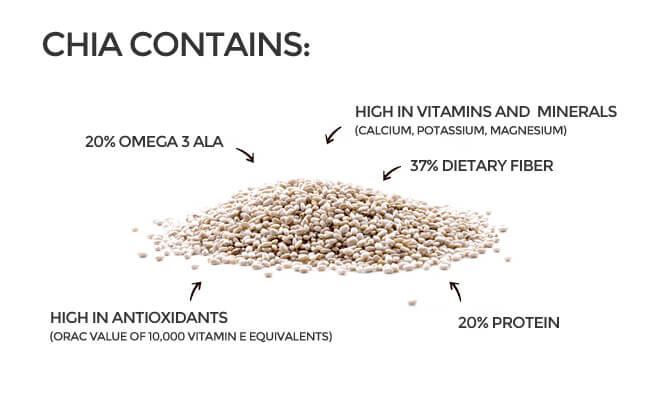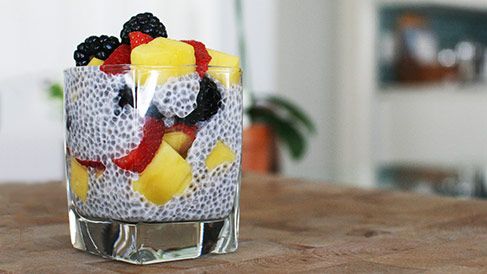Chia seeds – are they a ‘superfood’ or just a fad?
According to Fortune Business Insights, chia seeds are gaining immense recognition in the world market, due to its healthful properties, increasing demand for natural food ingredients, rising demand for health and dietary supplements.
But when I was growing up, chia wasn’t on the menu. In fact, the only thing I know about chia was ‘As Seen On TV’ Chia Pets, those funny clay figurines that you’d water and be infinitely entertained as the thing started to grow green fur. It was fun, but you wouldn’t eat it.
(The mystery of the furry pet was the impregnation of wet clay with tiny chia seeds.)

Chia Pet: infinitely entertaining
Today this ancient ‘pseudo-grain’ is forging a place in health-conscious consumer’s cuisine.
But does chia miraculously make you lose weight? Give you super-energy, endurance, sexual potency? With a quick “Google” search you’ll find countless websites hawking this “phenomenal” and “miraculous” tiny seed.
Yes, there are some small studies that point the way toward health benefits associated with regular intake. Benefits are thought to include satiety, leading to weight loss, lower blood pressure, better glucose control. And, undoubtedly the little nits are packed with nutrients. But conclusive studies?
There’s a lot right about chia seeds, and as is usual, there’s some truth and some myths associated with outlandish nutritional claims. Let’s peel back that onion.
What is chia anyway?
Chia seeds are from a flowering plant in the mint family called salvia hispanica, native to central and southern Mexico and Guatemala. Wikipedia reports that the word “chia” is derived from the Nahuati word chian, meaning oily.
According to AncientGrains.com, the Aztecs are the first recorded culture to utilize the seed as an edible component of their diets, about 3500 B.C.
Is chia a ‘superfood’? That’s a nonsense term, but chia does have some appreciable nutrition. Chia won’t undo that order of ribs and fries, but chia seeds are an excellent source of fiber and vitamins and minerals. Since they are not a grain, they are gluten-free.
Chia contains healthy fats:
Chia seeds are one of the richest plant sources of alpha-linolenic acid (ALA), an omega-3 fatty acid that’s linked to a reduction in inflammation and enhanced cognition. ALA is an essential fatty acid, which means we need to obtain it from food sources. Chia has the perfect polyunsaturated fat ratio of 3:1, omega-3 to omega-6.
Chia has minerals!
For a tiny seed, chia packs a calcium punch. Just two tablespoons contain 18% of the Daily Recommended Intake (DRI) for calcium, 35% for phosphorus, 24% for magnesium, and about 50% for manganese. These nutrients are linked to healthy blood pressure and are important nutrients for DNA synthesis.
Satiety and weight management:
Chia DOES make you feel full! But the fullness factor isn’t as beneficial if you just sprinkle chia dry on your food — and consuming chia seeds raw also means tiny seeds getting stuck in your teeth! Chia seeds are unique in their ability to absorb as much as 12 times its weight in water. Soaking the seeds change them from little dots to a lovely, gelatinous gel. In this form the transformation allows the seed to strut its stuff, slowing digestion and increasing fullness, even preventing dehydration and helping to balance blood sugar and cholesterol.
Black chia or white chia? Which is better?
According to Beyond the Equator, Chia seeds are naturally grown as a mix of both black and white seeds. The black chia seeds, defined by a veined or swirled coloring, make up the majority of chia seeds grown today. White chia seeds are found in much lower percentages and are slightly larger than their black counterparts. Nutritionally they are just about equal, with the black seed containing just a tiny bit more protein and the white seeds with just a bit more ALA Omega-3 fatty acids.
Enjoy chia:
To soak: Using a ratio of 1/3 cup chia seeds to 2 cups of water: take a mason jar, add water, add seeds and thoroughly stir or shake for 2 minutes, and refrigerate overnight. Forgot to soak? When you’re ready to eat, just swish the chia and water in the sealed mason jar for about five minutes and let sit for another 5 to 10 minutes, and you’ll have a decent chia gel.
Have a minute? Watch chia seeds expand – it’s amazing!
Add more flavor and nutrition by soaking in fresh coconut water, almond, soy, or coconut milk, or 100% (unsweetened) juice, unsweetened yogurt, oatmeal, or soup. If you like a sweeter taste, add your own. It will be far less than a manufactured juice or yogurt contains… I guarantee it.
More ideas adapted from the Academy of Nutrition and Dietetics:
- Use chia gel to bind veggie patties or as a thickener in soups.
- Mix ground chia into flour to boost nutrients in baked goods like muffins, cookies, and cakes.
- Soaked and hydrated chia can add fluffiness to gluten-free menu items like waffles and pancakes, too.
- Use hydrated chia seeds as an egg substitute in vegan and egg-free baked goods. Check out this recipe from VeganBaking.net.
Food Facts:
How much chia should you eat daily? It depends on you, your diet, and how much fiber you’re eating daily. Since chia is full of soluble fiber, be sure to add sufficient fluid as well, or else there’s a possibility of digestive upset. An ounce, or about two tablespoons, contains about 136 calories, 4.6 grams of protein, 8.6 grams of almost all unsaturated fat, and 11.8 grams of carbohydrate, almost all carbohydrate from fiber (9.6 grams.)
But soak first: when you soak the seeds first, either overnight or as mentioned, you absorb more of the nutritional and health benefits: soak at least 10 minutes before consuming.
Store dry seeds in the fridge, with a tight-fitting lid, for several months.
Ground chia seeds should be placed in a container with a tight-fitting lid, good for about a month. If you make chia gel it will keep for about two weeks in the fridge.
Remember, all chia seeds are not equal. In Cuenca, they’re available everywhere, from Supermaxi, to Coral, to any number of natural food stores throughout the city and even some local tiendas. I’ve also seen chia seed oil in natural foods stores, but be sure it’s sourced from a reputable manufacturer, sold in a dark glass bottle (to prevent rancidity), and preferably organic.
Please note: Don’t overdo
Too much dry chia to your diet can have unpleasant consequences, or worse, dangerous ones. It’s very uncommon, but not unheard of — there have been reports of people eating about a tablespoon of dry seeds followed by a glass of water, straight, like medicine. But the seeds mixed with a half-cup of water landed in the esophagus and created a gel which created a blockage. Not a good idea.
Allergic possibility: If you are allergic to sesame or mustard seeds, avoid chia seeds.
And since regular chia seed intake is linked to an improvement in blood pressure and blood glucose, if you are taking medications to treat these conditions, and start consuming chia and exercising and improving your overall diet, then keep an eye on your numbers — you may reduce your needs for medications.
Easy Chia Recipe: Click here for some delicious recipes from WellnessMama. I’ve adapted one of my favorites, an easy Chia Seed Pudding, that takes just 10 minutes, and serves 4.
 Ingredients:
Ingredients:
2 cups liquid: your unsweetened milk of choice, either dairy, coconut, almond, or soy
½ cup chia seeds
½ teaspoon vanilla extract
¼ teaspoon almond extract (optional)
¼ cup (or less) of maple syrup, honey, or agave syrup
Instructions:
In a blender, process on high for 1-2 minutes until smooth. Pour blended mixture into a glass jar, seal and refrigerate for at least 4 hours, or overnight. It will be thick and delicious. For more ‘crunchy’ pudding put all ingredients into a glass jar and shake for 5 minutes and refrigerate.
Feel free to add other flavors, such as a sprinkle of cinnamon, organic cocoa, or coconut and/or coconut extract.
Nutritional information made with 1% milk and maple syrup: per serving: 274 calories, 7.3 g fat, 0.8 g saturated fat, 57 mg sodium, 383 g potassium, 10 g fiber, 29.8 g sugar, 42.5 g carbohydrate, 15.8% DV vitamin D, 17.1% DV calcium, 65.1% manganese, 14.3% DV zinc.
Sources:
AncientGrains.com. Chia seed history and origin.
Beyond the Equator. Black chia vs. white chia.
Food & Nutrition (Academy of Nutrition & Dietetics). Chia seeds: tiny seeds with a rich history.
FoodNavigator.com. Chia boom: With 239% growth, chia category set to hit $1 bn by 2020.
Fortune Business Insights. Chia Seed Market.
WellnessMama.com. Best chia seed pudding recipe (+5 delicious variations).
____________________________________

















